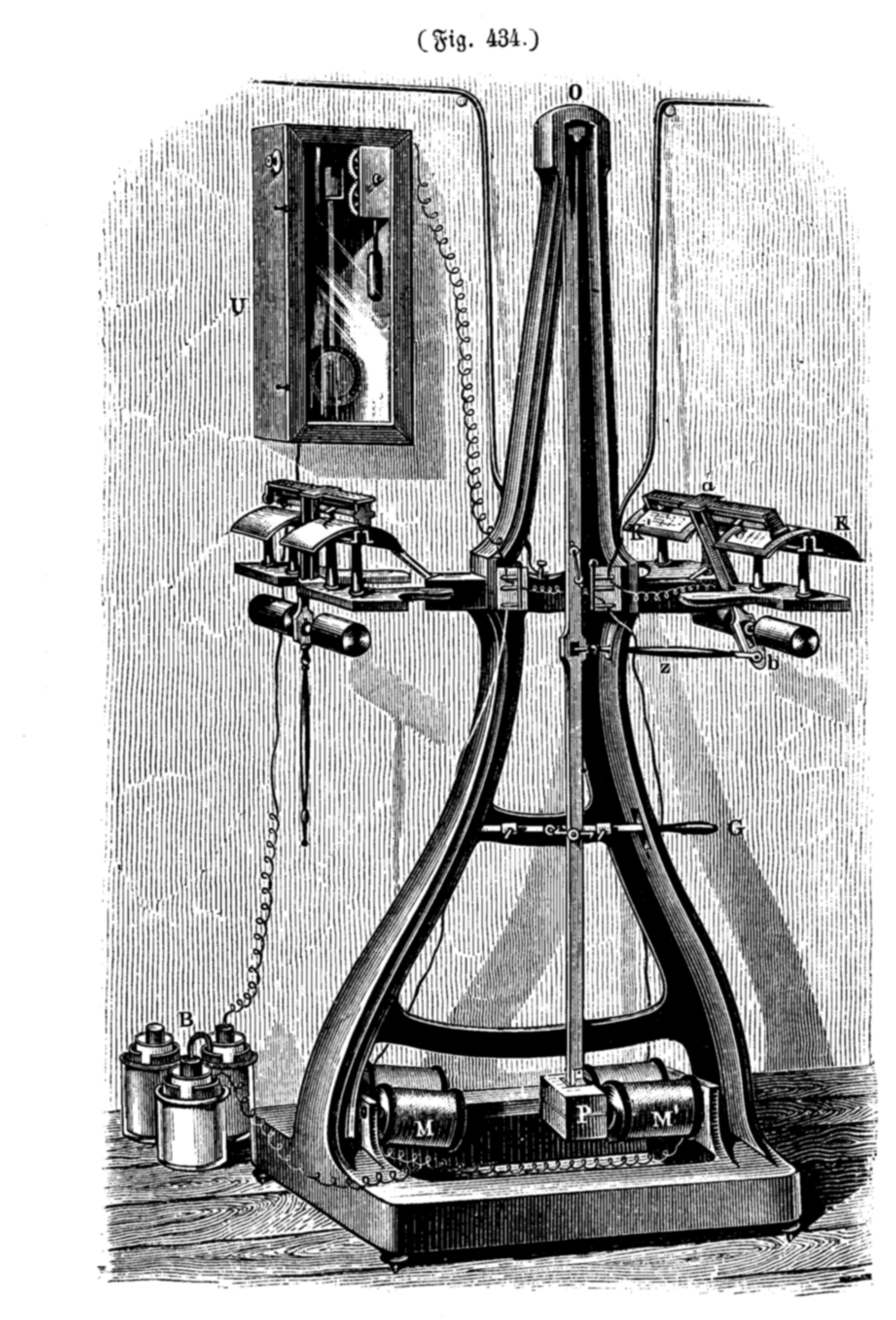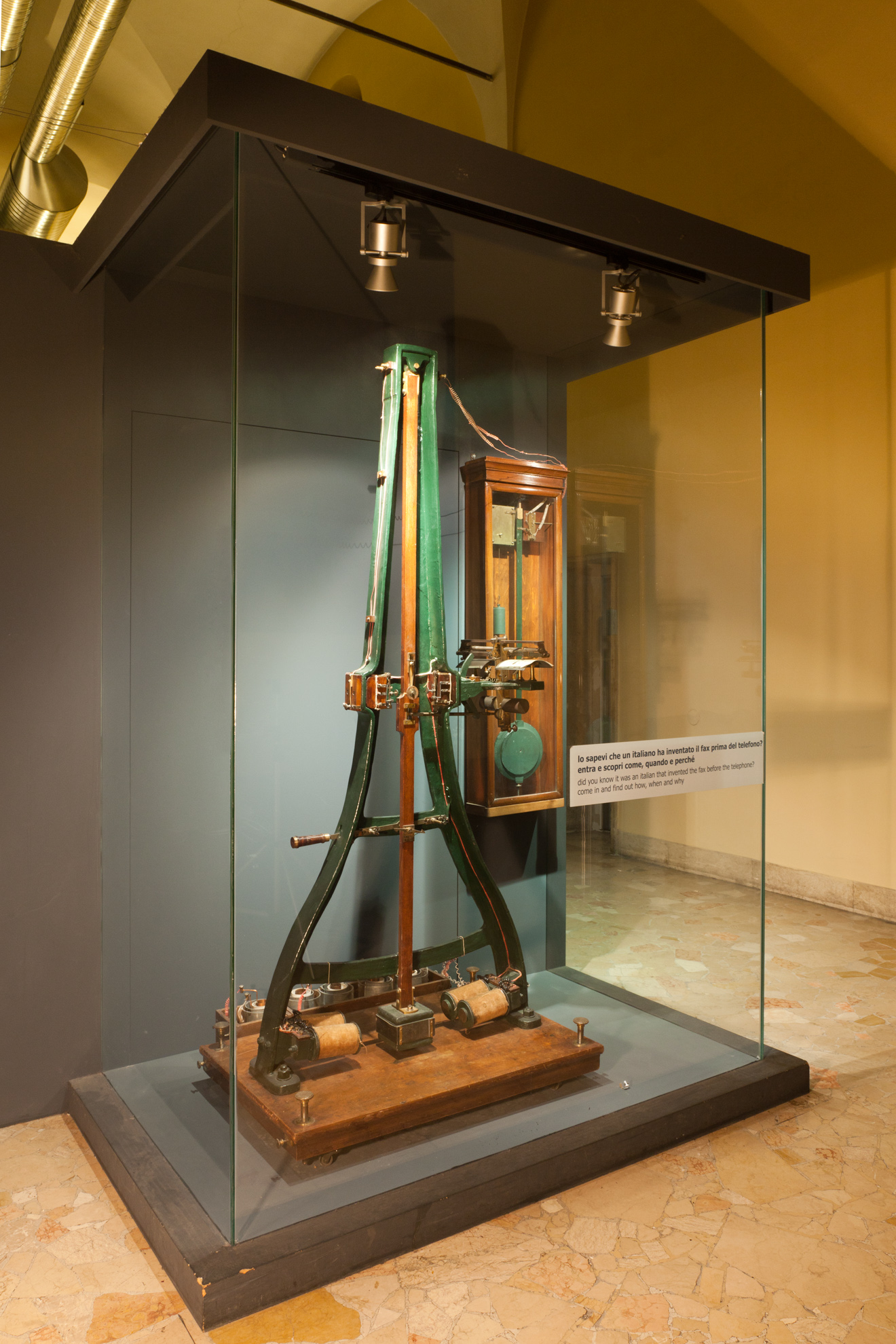Pantelegraph tinfoil mechanism.jpg on:
[Wikipedia]
[Google]
[Amazon]

 The pantelegraph (Italian: ''pantelegrafo''; French: ''pantélégraphe'') was an early form of facsimile machine transmitting over normal telegraph lines developed by Giovanni Caselli, used commercially in the 1860s, that was the first such device to enter practical service. It could transmit handwriting, signatures, or drawings within an area of up to .
The pantelegraph (Italian: ''pantelegrafo''; French: ''pantélégraphe'') was an early form of facsimile machine transmitting over normal telegraph lines developed by Giovanni Caselli, used commercially in the 1860s, that was the first such device to enter practical service. It could transmit handwriting, signatures, or drawings within an area of up to .

 While employed teaching physics at the University of Florence, Giovanni Caselli devoted much time to research into the telegraphic transmission of images. The major problem of the time was to get perfect synchronization between the transmitting and receiving parts so they would work together correctly. Caselli developed an electrochemical technology with a "synchronizing apparatus" (regulating clock) to make the sending and receiving mechanisms work together that was far superior to any technology
While employed teaching physics at the University of Florence, Giovanni Caselli devoted much time to research into the telegraphic transmission of images. The major problem of the time was to get perfect synchronization between the transmitting and receiving parts so they would work together correctly. Caselli developed an electrochemical technology with a "synchronizing apparatus" (regulating clock) to make the sending and receiving mechanisms work together that was far superior to any technology
/ref> By 1856, he had made sufficient progress for
Giovanni Caselli
by Eugenii Katz. Internet Archive version.
Facsimile & SSTV History
— ''this site has many images'' * {{cite web , url=http://www.secretlifeofmachines.com/secret_life_of_the_fax_machine.shtml , title=Secret Life of The Fax Machine , authorlink=Tim Hunkin , first=Tim , last=Hunkin
History of The Pantelegraph
— Information and More Pictures on the Pantelegraph
— Biographical and Historical Account of the Pantelegraph Telecommunications equipment Telegraphy Italian inventions Fax

 The pantelegraph (Italian: ''pantelegrafo''; French: ''pantélégraphe'') was an early form of facsimile machine transmitting over normal telegraph lines developed by Giovanni Caselli, used commercially in the 1860s, that was the first such device to enter practical service. It could transmit handwriting, signatures, or drawings within an area of up to .
The pantelegraph (Italian: ''pantelegrafo''; French: ''pantélégraphe'') was an early form of facsimile machine transmitting over normal telegraph lines developed by Giovanni Caselli, used commercially in the 1860s, that was the first such device to enter practical service. It could transmit handwriting, signatures, or drawings within an area of up to .
Description
The pantelegraph used a regulating clock with a pendulum which made and broke the current for magnetizing its regulators, and ensured that the transmitter's scanning stylus and the receiver's writing stylus remained in step. To provide a time base, a large pendulum was used weighing , mounted on a frame high. Two messages were written with insulating ink on two fixed metal plates; one plate was scanned as the pendulum moved to the right and the other as the pendulum moved to the left, so that two messages could be transmitted per cycle. The receiving apparatus reproduced the transmitted image by means of paper impregnated with potassium ferricyanide, which darkened when an electric current passed through it from the synchronized stylus. In operation the pantelegraph was relatively slow; a sheet of paper , with about 25 handwritten words, took 108 seconds to transmit. The most common use of the pantelegraph was for signature verification in banking transactions.History

 While employed teaching physics at the University of Florence, Giovanni Caselli devoted much time to research into the telegraphic transmission of images. The major problem of the time was to get perfect synchronization between the transmitting and receiving parts so they would work together correctly. Caselli developed an electrochemical technology with a "synchronizing apparatus" (regulating clock) to make the sending and receiving mechanisms work together that was far superior to any technology
While employed teaching physics at the University of Florence, Giovanni Caselli devoted much time to research into the telegraphic transmission of images. The major problem of the time was to get perfect synchronization between the transmitting and receiving parts so they would work together correctly. Caselli developed an electrochemical technology with a "synchronizing apparatus" (regulating clock) to make the sending and receiving mechanisms work together that was far superior to any technology Bain
Bain may refer to:
People
* Bain (surname), origin and list of people with the surname
* Bain of Tulloch, Scottish family
* Bain Stewart, Australian film producer, husband of Leah Purcell
* Saint Bain (died c. 711 AD), Bishop of Thérouanne, Ab ...
or Bakewell
Bakewell is a market town and civil parish in the Derbyshire Dales district of Derbyshire, England, known also for its local Bakewell pudding. It lies on the River Wye, about 13 miles (21 km) south-west of Sheffield. In the 2011 census, ...
had.Mid Nineteenth Century Electrochemistry/ref> By 1856, he had made sufficient progress for
Leopold II, Grand Duke of Tuscany
Leopold II( it, Leopoldo Giovanni Giuseppe Francesco Ferdinando Carlo, german: Leopold Johann Joseph Franz Ferdinand Karl, English: ''Leopold John Joseph Francis Ferdinand Charles''. (3 October 1797 – 29 January 1870) was Grand Duke of Tusc ...
to take an interest in his work, and the following year he travelled to Paris where he was assisted by the engineer Paul-Gustave Froment
Paul-Gustave Froment (born March 3, 1815 in Paris, died 1865) was a French mechanic, instrument maker and inventor.
Life
He was born in Paris and was educated at the Collège Sainte-Barbe and the Lycée Louis-le-Grand. Having demonstrated fro ...
, to whom he had been recommended by Léon Foucault, to construct the first pantelegraph. In 1858, Caselli's improved version was demonstrated by French physicist Alexandre-Edmond Becquerel
Alexandre-Edmond Becquerel (24 March 1820 – 11 May 1891), known as Edmond Becquerel, was a French physicist who studied the solar spectrum, magnetism, electricity and optics. He is credited with the discovery of the photovoltaic effect, the op ...
at the French Academy of Sciences
The French Academy of Sciences (French: ''Académie des sciences'') is a learned society, founded in 1666 by Louis XIV of France, Louis XIV at the suggestion of Jean-Baptiste Colbert, to encourage and protect the spirit of French Scientific me ...
in Paris.
On 10 May 1860 Napoleon III visited Froment's workshop to observe a demonstration of the device, and was so enthused by the device that he secured access for Caselli to the telegraph lines he needed to further his work, from Froment's workshops to the Paris Observatory
The Paris Observatory (french: Observatoire de Paris ), a research institution of the Paris Sciences et Lettres University, is the foremost astronomical observatory of France, and one of the largest astronomical centers in the world. Its histor ...
. In November 1860 a telegraph line between Paris and Amiens was allotted to Caselli which enabled a true long-distance experiment, which was a complete success, with the signature of the composer Gioacchino Rossini as the image sent and received, over a distance of . The composer wrote a piece, allegretto ‘del pantelegrafo’, for piano, marking the event.
The first "pantelegram" was sent from Lyon to Paris on 10 February 1862. The Corps législatif later ordered the installation of the pantelegraph on the railway line between the two cities, and from February 1863 the public was able to use it. French law was enacted in 1864 for the pantelegraph facsimile system to be officially accepted. The next year in 1865 the operations started with the Paris to Lyon line and extended to Marseille in 1867. ''This test was also successful, so that the pantelegraph became accepted for use on the French telegraph network by law on April 24, 1864. Official operation started on the Paris-Lyon line on February 16, 1865 and was extended to Marseille in 1867.''
Russian Tsar Alexander II installed an experimental service between his palaces in Saint Petersburg and Moscow between 1864 and 1865.
In 1867 the Director of Telegraphs, de Vougy, had a second line set up from Lyon to Marseille; the transmission cost was 20 centimes per square centimetre of image, and the service was operated until 1870.
Surviving machines
There are few remaining examples of the original pantelegraph. A formidable display of the pantelegraph was mounted in 1961 at the Musée National des Techniques, when a centennial celebration of the device was performed between Paris and Marseille. Again in 1982 their reliability was displayed; at the Postal Museum inRiquewihr
Riquewihr (; Alsatian: ; german: Reichenweier ) is a commune in the Haut-Rhin department in Grand Est in north-eastern France.
A popular tourist attraction for its historical architecture, Riquewihr is also known for the Riesling and other wine ...
, two pantelegraphs were used for six hours a day, for several months, performing without error.
An original specimen is also kept on display at the ''Istituto Della Porta'' in Naples.
One pantelegraph is in Munich (German Museum
The Deutsches Museum (''German Museum'', officially (English: ''German Museum of Masterpieces of Science and Technology'')) in Munich, Germany, is the world's largest museum of science and technology, with about 28,000 exhibited objects from ...
); it was (as of 2007) never displayed.
Literature
*Footnotes
References
* * *External links
Giovanni Caselli
by Eugenii Katz. Internet Archive version.
Facsimile & SSTV History
— ''this site has many images'' * {{cite web , url=http://www.secretlifeofmachines.com/secret_life_of_the_fax_machine.shtml , title=Secret Life of The Fax Machine , authorlink=Tim Hunkin , first=Tim , last=Hunkin
History of The Pantelegraph
— Information and More Pictures on the Pantelegraph
— Biographical and Historical Account of the Pantelegraph Telecommunications equipment Telegraphy Italian inventions Fax